Yes, one can say without any iota of doubt that the normal sewing machine can be used for sewing leather. One should use only a leather needle, the thread of either nylon or polyester type, tension where required, and the length of the stitch longer than normal. Using a Teflon or roller foot also facilitates smoother sewing on leather.
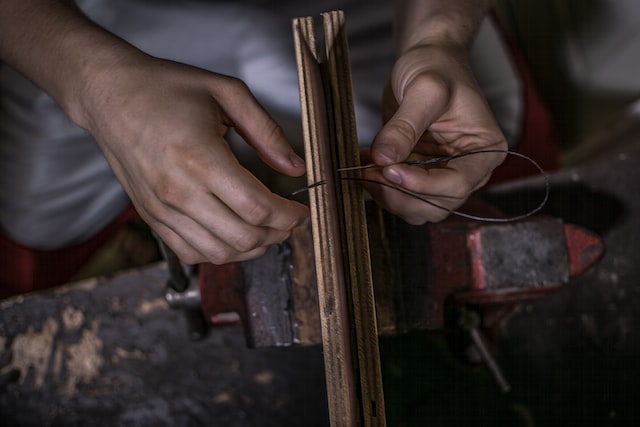
There you have it; it is possible to sew leather with your ordinary machine. This blog article tries to cover simple basics of sewing leather, things like what kind of machine would one need, and, of course, supplies. We’ll also explain some tips that will help make your project easier and more successful. So let’s get started!
How to Sew Leather on Your Sewing Machine?
Introduction to Leather Sewing
Venturing into the realm of sewing leather at home is both a challenge and an adventure. As someone who has spent countless hours mastering the craft, I can attest to the unique satisfaction that comes from turning a piece of leather into a beautiful, functional object. Leather demands respect and patience, necessitating the use of precise tools and techniques. Understanding these requirements is the first step towards ensuring the longevity and aesthetic appeal of your projects, making the sewing experience not just productive but truly enjoyable.
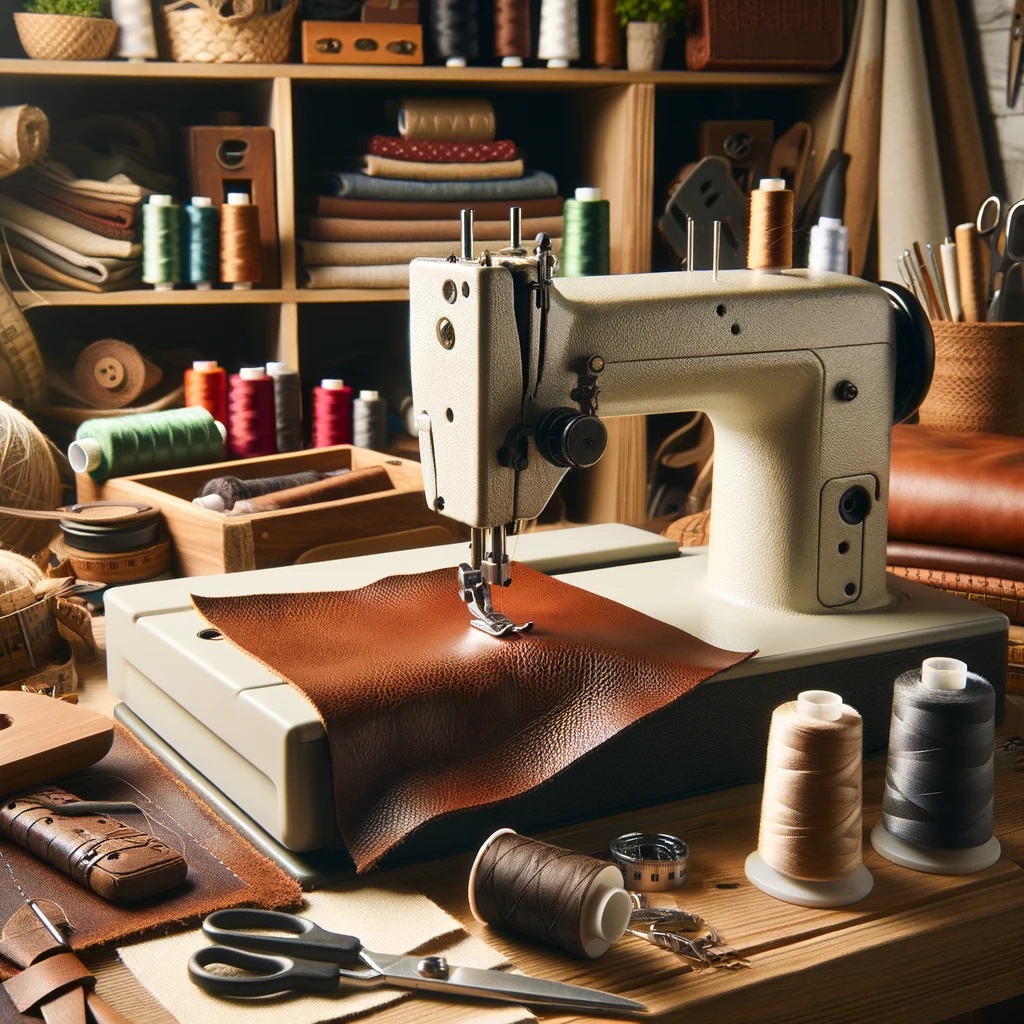
Choosing the Right Leather
The choice of leather can make or break your project. Over the years, I’ve learned that softer, more pliable leathers like lambskin, pigskin, and some varieties of calfskin are ideal for beginners and can be beautifully crafted using a standard sewing machine. These insights come from experimenting with various materials and understanding their behavior under different conditions. Selecting the right type of leather is essential, as it must align with both the demands of your project and the capabilities of your sewing equipment.
Essential Tools and Materials
A cornerstone of sewing with leather is the selection of appropriate tools and materials. My experience has shown me that specialized leather needles and heavy-duty thread are non-negotiable for achieving durable and professional-looking seams. Traditional methods of pinning and basting do not apply here; instead, innovative solutions like binder clips or double-sided tape offer effective alternatives that protect the integrity of the leather.
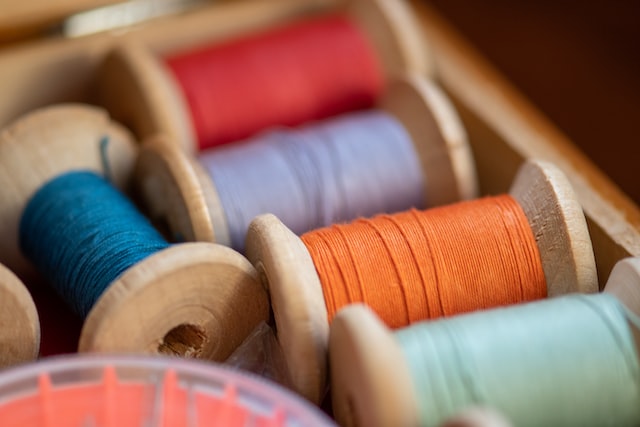
The choice of presser foot is another area where my expertise has been invaluable. A Teflon foot, roller foot, or walking foot can greatly enhance your sewing experience, facilitating smooth fabric feed and preventing the leather from sticking. These tools are not just accessories but essential allies in managing the unique challenges leather presents.
Prepping Your Sewing Machine
Adjusting your sewing machine for leather is a critical step that many overlook. Through trial and error, I’ve found the optimal settings that cater to the thickness and resistance of leather. Selecting the right presser foot, adjusting to a longer stitch length (about 3 to 4 mm), and fine-tuning the tension settings are crucial adjustments that make a significant difference in the outcome of your projects.
Remember, the journey of sewing with leather is as much about the process as it is about the final product. With patience, practice, and a willingness to learn, you’ll discover the immense satisfaction that comes from mastering this noble craft. Whether you’re taking your first steps into leather sewing or looking to refine your skills further, embrace the challenges and let your creativity soar.
Sewing Your First Seam
When it comes to sewing leather, the initiation of your first seam is pivotal. A common challenge is preventing the leather from being caught by the feed dogs. To navigate this, begin with a slightly longer stitch length and consider placing a piece of tissue paper between the leather and the feed dogs, which can be easily removed after sewing. This method not only safeguards the leather but also ensures a smooth start to your seam.
Seam Types and Their Applications
Understanding the variety of seams—regular, lapped, welt, and flat-felled—and their specific applications is crucial. Each seam type offers its distinct advantages, depending on the project at hand:
- Regular seams are your go-to for most projects, offering simplicity and strength.
- Lapped seams provide an aesthetically pleasing finish with added durability, perfect for thicker leathers.
- Welt seams are ideal for adding definition and structure to your pieces.
- Flat-felled seams boast immense strength, making them suitable for items requiring resilience.
Mastering the execution of these seams, and knowing when to employ each, elevates the quality of your leatherwork significantly.
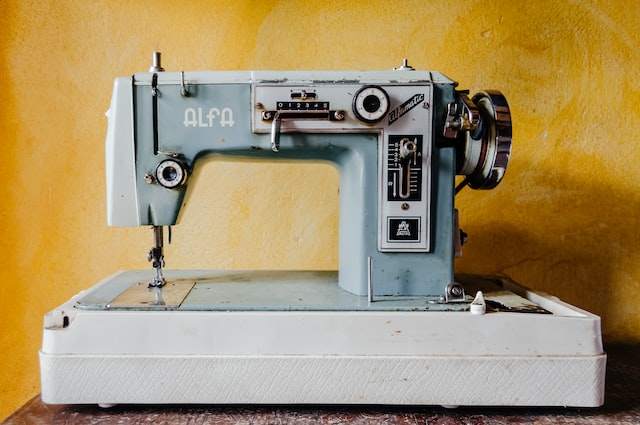
Avoiding Common Mistakes
A pivotal piece of advice for those new to leather sewing is to avoid backstitching at the start and end of your seams. Leather, being a more unforgiving material, can show every needle mark. Instead, leave thread tails and tie them off manually for a clean finish.
Advanced Techniques
As your confidence grows, exploring advanced techniques such as sewing through thicker layers or adding decorative top stitching can add depth and character to your projects. A key tip for managing thicker layers is to use a leather-specific needle and adjust the tension on your sewing machine accordingly. For decorative top stitching, ensure your stitch length is slightly longer to create a pronounced effect that stands out on the leather.
Post-Sewing Care
The longevity of your sewing machine is paramount, especially after working with leather. Cleaning and maintaining your sewing machine post-project prevents the buildup of leather fibers and ensures smooth operation for future projects. Regularly oiling your machine, using a nylon brush to remove debris, and changing needles frequently are practices that keep your equipment in top condition.
Understanding Leather Sewing with Regular Machines
So, you’re ready to dive in and understand just how to master sewing leather with a regular sewing machine and make sure your projects start on the right foot and cross the finish line with flair.
Selecting the Right Leather
Not all leathers are considered equal, especially about using your regular old sewing machine. This will determine an absolute different thickness and flexibility. Better to use soft, pliable leathers such as lambskin, goatskin, or thinner cuts of cowhide, which will let the needle penetrate without too much force, therefore reducing the risks involved with your machine and also the material. Not so much the “correct type” of leather is selected not just for it to be readily sewn, but to choose one which, although not stretchy, would suitably bring your vision to life and be fully matched for the demands of your project.
The Critical Role of Needles and Threads
Then, the needles and threads you select will just be acting the jon of your sewing leather should be. The needles are characterized by their three-edged points and are used in piercing hard materials without causing tears or rips.
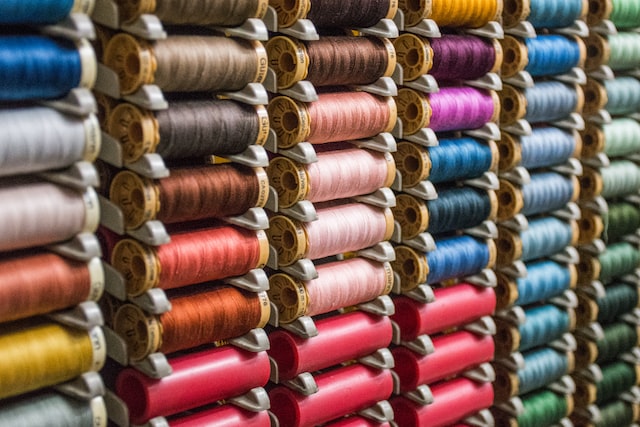
Another important thing is to pair the needles with the right kind of thread. For this reason, heavy-duty polyester or nylon threads are recommended. Such a perfect combination will assure the seam will have the strength enough to withstand the special pressure which the leather will subject them to.
Exploring Alternative Machines
Though any good sewing machine should be able to sew even lightweight leather perfectly well, sometimes one really does have to call in the heavy infantry for heavyweight projects. That’s where vintage and industrial sewing machines excel. Usually, with vintage machines, tougher leathers are quite simply powered right through with their robust build and mechanical simplicity. On the other hand, industrial machine setups for hard tasks allow much more power and control of speed. Understanding their potential could make you a more enlightened choice in tackling even your most daunting leather projects.
Preparing Your Sewing Machine
Here, I shall give some hints that will help you prepare your sewing machine for leather expertly so that your projects start well and have that neat finish that professionals get.
Adjusting Your Machine:
This is not so much a step as a leap from sewing fabric to leather; your sewing machine must be able to cut it. First up is changing the presser foot.
All the sewing should be done with a Teflon, roller, or walking foot that helps to control the texture of the leather so that the fabric does not stick or stretch while sewing. All these feet have their definite purposes, and knowing their use would be greatly paramount in sewing.
Most importantly, use the right needle. Leather needles are pointed triangularly, not to tear during penetration. This little tip can quite literally be the make or break for the integrity of your stitches and the overall look of your project.
Another important aspect is to adjust the tension settings on your machine. Leather does require balancing, because too much tension may produce puckered seams or broken threads. At the same time, excess tension in the setting pulls up the needle and fails to catch the bobbin thread, hence creating a chain of loose stitches on the fabric. That often means playing a little bit of trial and error because the ideal setting can change based on the thickness and kind of leather you are working with.
The Significance of Leather-Specific Tools:
What really makes a difference, even when you are reasonably well-prepared, is really the significance of complementing your sewing machine with leather-specific tools, such as the rotary cutter and sewing awl. This is what the rotary cutter will offer you—clean and straight cuts, something very important for stitching and sewing preparation. In contrast, a sewing awl can be very helpful to make pilot holes or for hand-stitching, not allowing the needle on your machine to go through the leather very easily.
10 Best Tips to Sew Leather with a Regular Sewing Machine
Sewing leather with the standard sewing machine might seem a bit daunting at first, but realistically—probably with some techniques and a bit of know-how—it’s perfectly doable.
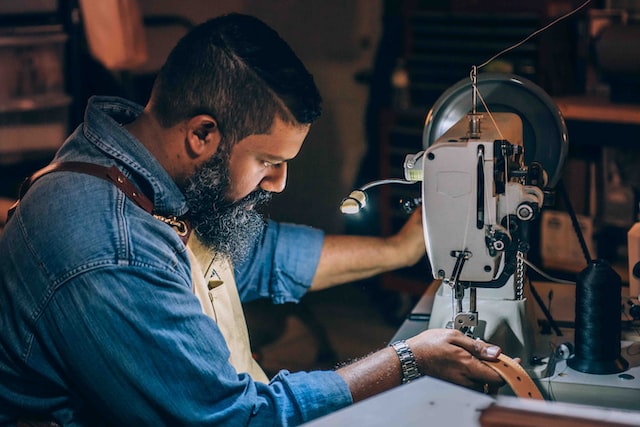
I’ve been doing this for years and have probably seen the most common sewing mishaps, which I will be pointing out here.
It gives you the confidence to embark on such leather projects, ensuring that your sewing encounters are smooth and rewarding, full of loads of expert tips.
Let’s take a look at the ten best tips for sewing leather with a home sewing machine. It’s really a treasure trove of wisdom gained from experience and dedicated sewing.
- Choose the right leather: Look for softer and thinner leather, which your machine can easily handle. Thicker or much stiffer leathers may need a more powerful machine.
- Consider trying a Teflon foot or a roller foot: Either of these specialized presser feet should prevent the leather from sticking to them and therefore allow the machine to feed the material through more efficiently.
- Leather Needles: The needles are applied to the leather in extra-sharpened form so that the penetration over the surface of the leather is without damage.
- Use Heavy-Duty Threads: A heavy-duty polyester or nylon thread, with enough weight to hold the weight and the texture of the leather together, makes the seam strong and durable.
- Adjust Stitch Length: Increase your stitch length to 3-4mm. This is done so as not to tear the leather because very many punches are found close to each other, hence creating weakness in the material.
- Scrap Test: You can practice stitches on pieces of the same leather, so you do not screw up if the settings are not right before starting the actual project.
- No pins: Pins will make permanent holes in your leather material. Use clips or double-sided tape to hold your leather in place while stitching.
- Gentle Handling: The leather might stretch or distort from its shape if pulled or roughly handled. Let the feed dogs take the material through without additional force.
- Strengthening Seams without Backstitching: Since the marks of backstitches remain pretty ugly on leather, so strengthen your seams by tying off the ends of threads manually.
- Regular maintenance of the machine: Working with leather is bound to make it leave residues in your machine. Do not fail to clear and do oiling after a lapse of some time in your sewing machine for your convenience and good working condition.
So take your time, especially if you are a novice to sewing with leather. Mistakes that are hard to correct on such a forgiving material.
Do you need a special needle to sew leather?
No, you don’t need a special needle to sew leather. A regular needle will work just fine. The main thing you need to be aware of when sewing leather is that it’s a thicker material, so you’ll need to use a heavier thread.
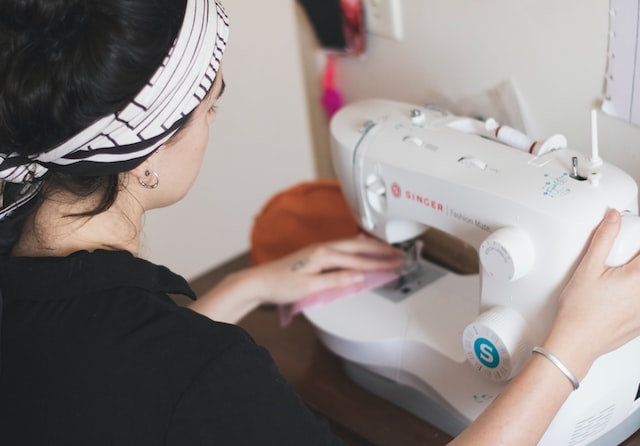
FAQs
Can any type of leather be sewn with a regular sewing machine?
No, not all types of leather can be sewn with a regular sewing machine. You need to use a thicker needle and thread and make sure you don’t overload your machine. Sewing thick or multiple layers of leather can damage your needle and/or your machine.
What are the benefits of using a regular sewing machine for leather?
There are several benefits to using a regular sewing machine for leather. First, it’s less expensive than buying a specialized Leather Sewing Machine. Second, it’s more versatile- you can use it for other projects besides just leather.
Can I sew all types of leather with a regular sewing machine?
Some leathers cannot be sewn using a regular sewing machine. Some leathers, such as lambskin or soft calfskin, can be sewn easily on a regular sewing machine, while thicker and firmer types will certainly need heavy-duty or industrial machines.
What needle size should I use for sewing leather?
When sewing through leather, always ensure that you use a leather needle. Sizes will vary depending on the thickness of the leather being worked, but common sizes vary from 90/14 to 110/18. Always pick the size of needle that will perfectly go into the leather cleanly without necessarily cutting it.
How do I adjust the tension for leather sewing?
If sewing with leather, you might need to adjust the tension settings in your machine. Start at a higher tension than you usually would with regular fabrics, making the first test on a scrap piece of leather. Adjust little by little until the smooth, even stitches are obtained without puckering or breaking the thread.
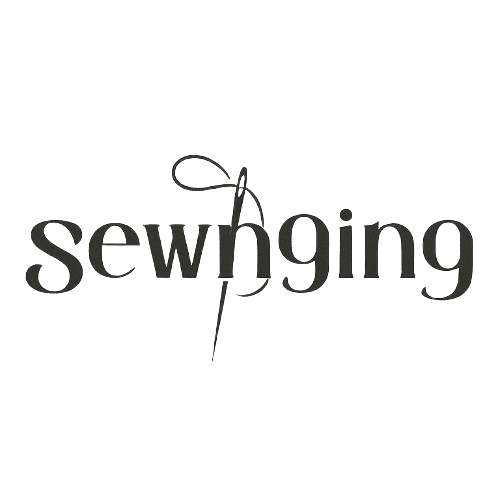
[…] we’ll provide a comprehensive guide on how to avoid and tackle some of the most common leather sewing problems and mistakes so that you can DIY your own creations with […]
[…] You can find just about anything on Amazon, including leather sewing […]